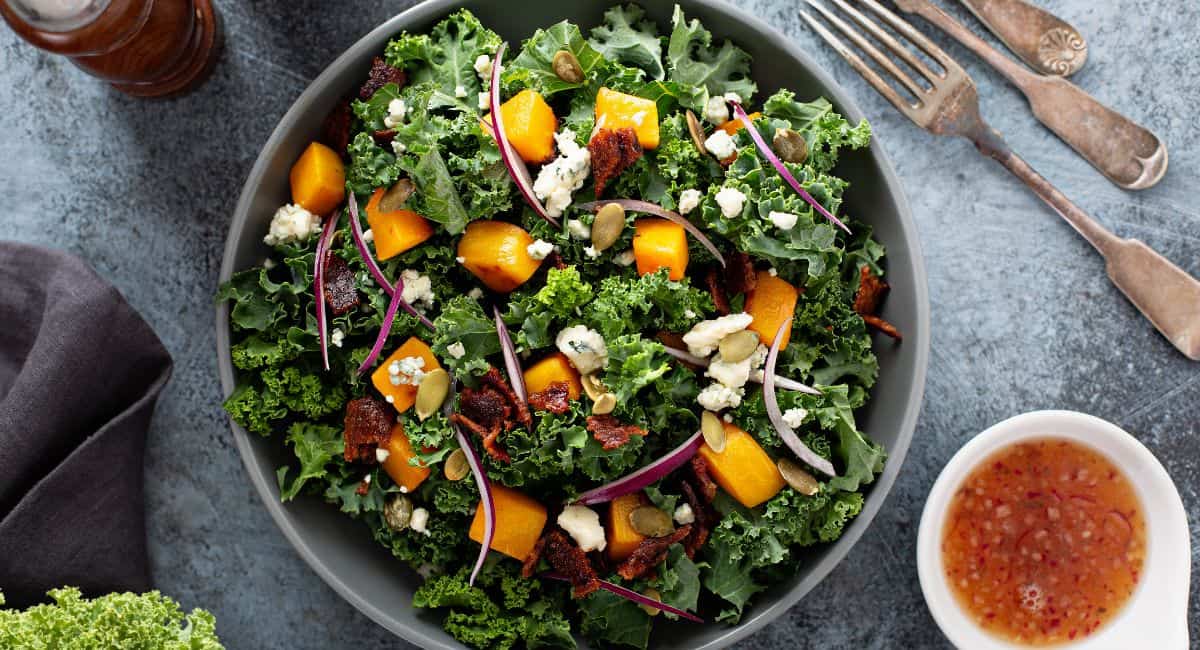What is Kale? Types, Nutrients and Benefits
Let’s examine exactly what kale is.
Kale is a leafy green that has been marketed as a “superfood” because of all of its amazing health benefits. This delicious vegetable is packed with tons of minerals, vitamins, and antioxidants, providing nourishment for your entire body.
It is part of the cabbage family along with broccoli, cauliflower, and collard greens.
It is an easy crop for local farmers and gardeners to grow since it thrives on small plots of land1. Unlike many other fruits and vegetables, kale grows extremely well during colder months, making it a wonderful addition to your winter menu.

As a Certified Health Coach many clients ask about kale and its benefits. Let’s take a close look.
What Are the Different Types of Kale?
There are four common types2 of kale:
- Curly kale is the most common. Its leaves are bright green with a ruffled texture and it has a hard stem.
- Dinosaur kale is very wrinkly and kind of resembles dinosaur skin, hence its name. It has a very thick stem that needs to be cut off before consumption.
- Redbor kale has ruffled leaves. Its color ranges from red to purple.
- Russian kale can be green, red, or purple. It is less common than the other varieties.
What Are the Health Benefits of Kale?
Kale has numerous health benefits. Listed below are the top 9 health benefits you’ll receive from eating kale.
Contains Powerful Antioxidants
Kale contains several antioxidants.
Antioxidants are powerful molecules that help protect your body from oxidative damage, which is known to progress aging and may cause certain diseases.
Kale includes two special types of antioxidants called quercetin and kaempferol. These antioxidants have been tested thoroughly on animals and revealed that quercetin and kaempferol might be extremely beneficial for humans.
Some studies suggest they may lower cholesterol3 and have a protective effect against inflammation and viruses4

May Help Lower Cholesterol
The liver turns cholesterol into bile acids. These bile acids are used to digest body fats after you eat a high-fat meal. After the fat has been absorbed by your system, the bile acids are returned to your bloodstream and used again the next time you eat something high in fat.
Kale contains bile acid sequestrants, which can bind to bile acids and prevent them from being reabsorbed, thereby lowering your cholesterol5.
Lower cholesterol is associated with a reduced chance of developing heart disease. So, by eating kale, you may be indirectly improving your heart health6.
Has a Lot of Vitamin C
Kale contains more Vitamin C than most other vegetables, making it the perfect source if you are trying to add more vitamin C to your diet.
Vitamin C is important because it helps lower blood pressure, decreases your risk of heart disease, and helps prevent gout attacks.
This amazing antioxidant also improves the body’s ability to absorb iron. This is important for individuals who have iron deficits, such as anemics.
One of the Top Sources of Vitamin K
Kale contains 7x more than the daily recommended amount of Vitamin K1.
Vitamin K1 is essential for blood clotting. This vitamin works by “activating” proteins, which permits them to bind to calcium. This leads to blood clotting.
You may be wondering, why is blood clotting a good thing? Well, clots are very important when you harm yourself because they prevent you from losing too much by stopping the bleeding. So, for this reason, having enough vitamin K1 in your system is very important.
Contains a Lot of Beta-Carotene
Kale contains beta-carotene, which is a type of antioxidant. The body is able to convert it into vitamin A.
Vitamin A is essential for normal body functioning.
This powerful vitamin plays a role in male and female reproduction since it aids in egg and sperm development.
Vitamin A is also needed to create B and T-cells, which are important for the immune system since they help guard the body against infection and disease.
Additionally, Vitamin A is crucial for maintaining eye health. It has a protective effect on the eyes and reduces the likelihood of getting certain diseases such as age-related macular degeneration. It’s also needed to create a molecule that is necessary for color and low light vision.
Provides You With Folate
Folate is a type of B-vitamin that is present in a variety of foods.
This vitamin is essential for having a healthy pregnancy. If a pregnant mother has high folate levels, it decreases the risk that her baby will experience congenital deformities. If you don’t have enough folic acid in your body while pregnant, you may experience complications.
Additionally, folate is crucial for mental health. Folate deficiencies have been linked to depression and have been found to negatively impact an individual’s response to antidepressant medications.
One study found that adding folate to the diet could improve depression by making people more receptive to their medication7.
Contains Several Minerals
Kale provides you with several minerals, such as phosphorus, potassium, calcium, magnesium, and zinc8.
- Phosphorus is important for maintaining strong bones and teeth. It also manages the way the body uses energy and assists in the growth and repair of tissues and cells. One of its most essential features is that it produces DNA and RNA, which are the basic building blocks of the body.
- Kale also includes a significant amount of potassium, which helps maintain fluid balance, nerve functioning, and muscle contractions. Potassium may also reduce blood pressure by helping the body remove excess sodium.
- Another important mineral kale contains is calcium, which is necessary for creating strong bones and teeth. Calcium also allows the body to move and permits the brain to carry messages to the rest of the body.
- Kale also contains magnesium. This mineral helps your body perform hundreds of chemical reactions. It is also very important for exercise. During workout activities, your body needs 10-20% more magnesium than while you are at rest since it helps eliminate lactate, which can build-up and cause fatigue. It also affects mood. If your magnesium levels are too low, it could cause various forms of mental illness, including depression.
- Zinc is another mineral you’ll get when you eat kale. Zinc decreases inflammation, helps get rid of acne, and might reduce your chances of getting certain age-related diseases, such as age-related macular degeneration. It also decreases the rate of infection experienced by older individuals.
High in Lutein and Zeaxanthin
Lutein and Zeaxanthin are nutrients beneficial for the eyes.
These wonderful nutrients have been found to reduce the risk that people will develop macular degeneration and cataracts.
A Weight Loss Aid
Kale is extremely low-cal, making it an ideal weight-loss food. In fact, a cup of raw kale has only 33 calories and 7 grams of carbs.
Although kale is low in calories, it is very filling. Better still, it contains a little bit of protein and fiber, which have both been proven to promote weight loss9.

Does Kale Have Any Downsides?
Kale can negatively impact individuals with certain conditions. Listed below are the ways in which kale can be harmful.
- Kale is high in goitrogens, which are compounds that can impact thyroid functioning. When you eat raw kale, you ingest a specific type of goitrogen called goitrins, which can decrease the amount of iodine your body can take in10. Iodine is important for thyroid hormone production, so inhibiting this mineral can be harmful to individuals with thyroid problems.
- Eating too much kale can also impact your metabolism. Thyroid hormones are needed to regulate your metabolism, so if you aren’t getting enough iodine to make sufficient amounts of these hormones you can experience weight gain, reduced energy levels, an irregular heartbeat, and more11.
- Individuals who use beta-blockers should be careful about their kale consumption. Beta-blockers are typically prescribed to people with heart disease. This type of medication increases the levels of potassium found in the blood. Kale contains a lot of potassium, so eating too much of it while taking beta-blockers can lead to excessive potassium levels.
- Individuals with kidney disease should be cautious when it comes to kale. If you eat too much kale your kidneys may not be able to process the high levels of potassium in your blood which can have detrimental effects.
In general, kale is safe for most people. Even individuals with the conditions listed above can often eat kale in moderate amounts.
However, if you have a thyroid problem, are on beta blockers, or have kidney disease, you should talk to your doctor before consuming kale to make sure it is safe for you!

How Can I Eat Kale?
Kale can be consumed in several ways. Listed below are some traditional ways to prepare kale to add this nutritious vegetable to your diet:
- Raw kale is a great addition to salads, sandwiches, or wrap. However, the leaves can be a bit tough, so you may want to scrunch them in your hands before eating them for easier digestion.
- Sauteed kale is delicious and nutritious. Simply add some kale into a skillet with olive oil, garlic, and some onions. Then, presto! You’ll have a wholesome side dish for dinner.
- Bake kale to create kale chips. These crispy chips are healthy and make a wonderful snack.
- Add kale to your smoothies. If you aren’t particularly fond of the taste of kale, this is a great way to receive all of its benefits without tasting its flavor.
If you have any questions about this article don’t hesitate to comment below or email us. You can find an email on our contact page.
Read Next – More Food vs Food!
This is How Much Kale You Should Eat Per Day
Farm-Raised Vs Wild-Caught Scallops: Which Seafood is Best?
Organic Carrots vs. Regular Carrots: What’s the Difference?
Organic Mango vs. Conventional Mango: Which is Better?
- USDA: Kale Grades and Standards [↩]
- Wikipedia: Kale [↩]
- ScienceDirect: Kale Juice Improves Coronary Artery Disease Risk Factors in Hypercholesterolemic Men [↩]
- SpringerLink: Sulforaphane as a Promising Molecule for Fighting Cancer [↩]
- Wikipedia: Bile acid sequestrate [↩]
- National Center for Biotechnology Information: Kale juice improves coronary artery disease risk factors in hypercholesterolemia men [↩]
- National Center for Biotechnology Information: Women with depression should be offered folic acid [↩]
- NutritionData: Kale [↩]
- MedlinePlus: Health food trends – kale [↩]
- National Center for Biotechnology Information: Concentrations of thiocyanate and goitrin in human plasma, their precursor concentrations in brassica vegetables, and associated potential risk for hypothyroidism [↩]
- National Center for Biotechnology Information: Thyroid Hormone Regulation of Metabolism [↩]
